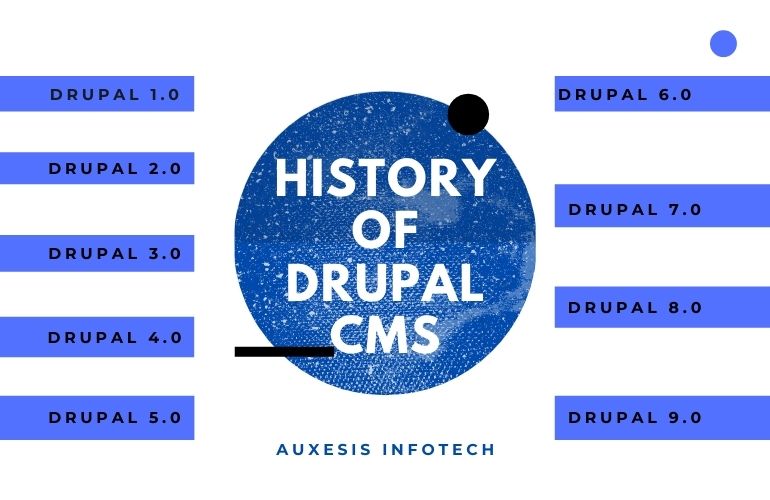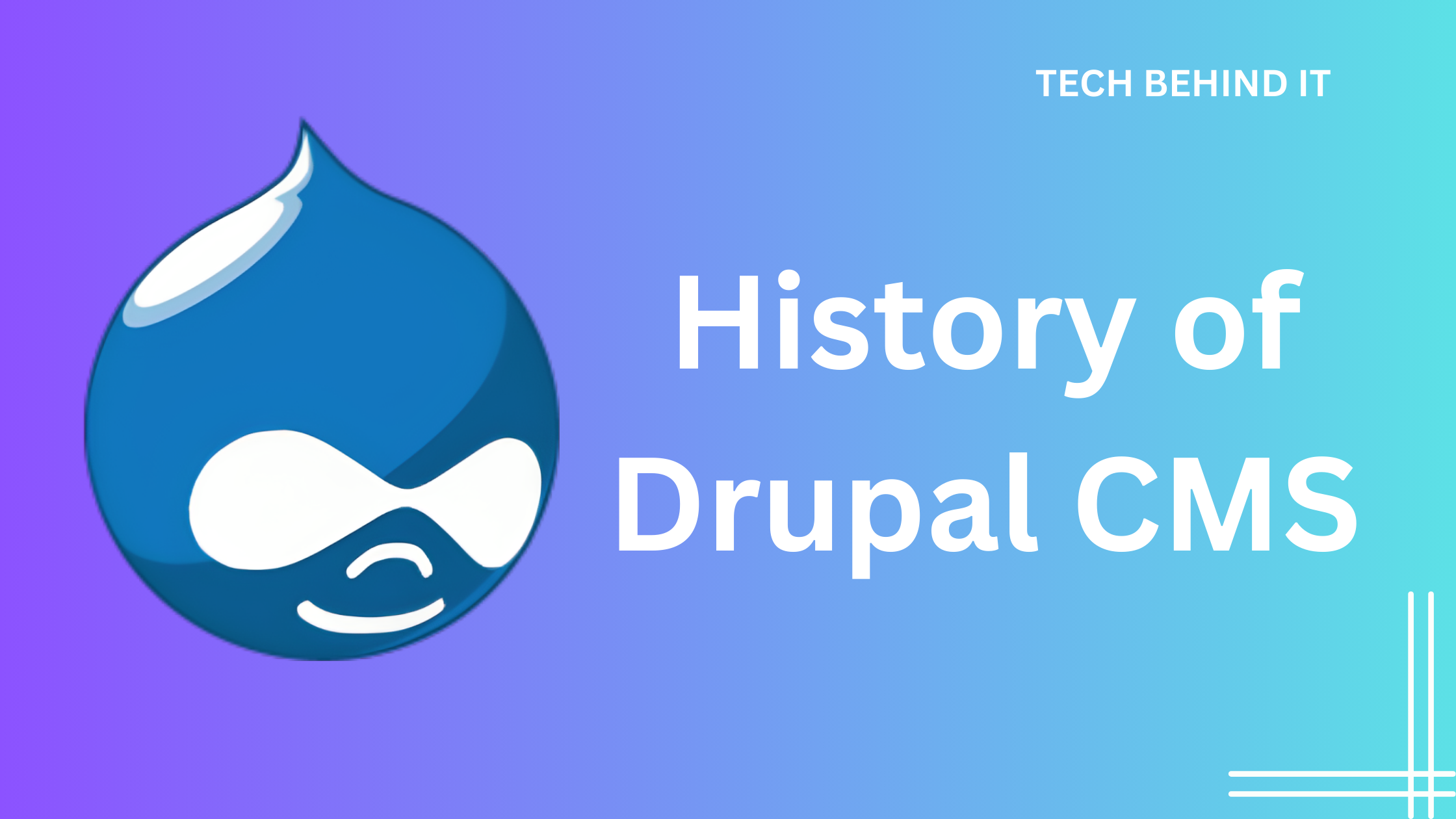History of Drupal CMS | All Drupal Version History
When it comes to top CMS platforms, Drupal is always placed somewhere on the top of the list. In the present time, Drupal is considered to be one of the most popular choices for developers and business owners to build a website.
Talking about Drupal, well, it is indeed one of the leading open-source CMS frameworks, used by custom web design agencies. As of May 2020, Drupal’s market share is 2.8%. This is a huge percentage, considering how many CMS platforms are available in the market. Coming on to the history of Drupal, it has a rich history that dates back to 2001. Yes, it has a long, rich history of 20 years. Hence, in this post, we learn about all the versions of Drupal that have been an integral part of Drupal’s rich history. So, here we go!
The software’s name was accidental. In 2001, Dries opened-sourced the project and registered a website. When searching for a free domain, he entered “drop.org” instead of “dorp.org.” (“Dorp” means “village” in Dutch, indicating the project’s communal focus from the start). He loved “drop” and kept it. The term became “druppel” (Dutch for “droplet“). He named the program Drupal because “druppel” sounds like “Drupal” in English when pronounced in Dutch. Over time, the software and community have developed significantly. Drupal.org has over 110,000 registered users, which will likely increase as you read this. This content management framework has seen eight significant releases since 2001.
All Drupal Versions | History Of Drupal

1) Drupal 1.0
Drupal 1.0, a.k.a. Drop, is the first version of Drupal, which was released on 15th January 2001. It was released with the 18 core modules. Each of these modules was a PHP file. This version of Drupal gave developers the option to enter code into one of the seven hooks in the modules. Along with that, this version also supported a feature where the admin hook could only be accessed by the administrator. Drupal 1.0 was built in such a way that it is said to provide adaptability, flexibility, and continuity. This made a lot of business owners drawn to Drupal to create a customized website without any difficulty. Another thing to know about Drupal 1.0 is the fact that the entire system was dependent on SQL to manage and modify themes, content, layout, and more.
Drupal was released on the web in January 2001 and was soon adopted by developers who liked its fully customizable modular design and extensive capabilities.
2 ) Drupal 2.0
Drupal 2.0 was introduced just a few months after the release of Drupal 1.0. It was released on 15th March 2001. Drupal 2.0 was more like a translation feature that allowed users to overwrite or create their websites in different languages. This version came up with a framework that enables developers to build a multilingual website by just editing SQL DB and configuration files manually. This version of Drupal supported 22 modules and also included a sector for stories and user ratings.
Early adopter input led to several modifications to core functionality, administrative interface, themes, and modules two months after release. Drupal 2 included these.
3) Drupal 3.0
Soon after the release of Drupal 2.0, Drupal 3.0 was released on 15th September 2001. Now, this version of Drupal was published with the concept of ‘nodes’ instead of pages. This means each and everything on Drupal 3.0 was presented as a node, be it the story, forum, blog, book, or diary. Besides, the number of modules reached t 26 in Drupal 3.0.
The next significant version later that year included considerable core programming modifications, new key modules, and better modules and themes.
4 ) Drupal 4.0
By the release of Drupal 4.0 in June 2002, more than hundreds of renowned websites were already built on Drupal. Besides, Drupal has also started receiving international acknowledgment as an open-source CMS platform. The key highlight of Drupal 4.0 was the taxonomy module that allows developers to replace meta tags and attributes. From the time 2002 to 2007, Drupal released updated versions from Drupal 4.1 to 4.7.
A caching feature was added to the next major release the following summer to speed up page loading for non-logged-in visitors. Additional functionality, administrative, and usability enhancements were made. After June 2002, work proceeded quickly. However, the following major upgrades were turned into sub-releases. Thus, Drupal 4.1 debuted eight months after Drupal 4. This continued at similar average intervals until version 4.7 was issued in May 2006.
5 ) Drupal 5.0
Released on 15th January 2007, Drupal 5.0 came up with jQuery, which is a JavaScript library, making HTML scripting a lot easier. It also included a reorganized module directory structure where all modules have their directory. Another critical improvement Drupal 5 came up with was the CSS preprocessor. Under this, all stylesheets were to be summed into a single compressed file. This ensured the better speed of the website.
Drupal’s next major release improved administration organization and layout customization. Many usability and browser speed enhancements were implemented, including a new default theme.
6 ) Drupal 6.0
On 13th February, Drupal released its sixth version. Till now, it was the most accessible version of Drupal. It received so much popularity that the White House even adopted Drupal 6. The key highlight or feature of this version of Drupal was the improved security and quick and easy setup drag and drop administration. Drupal 6 included a total of 34 core modules.
February 2008 upgrade was called another significant release, the same timeframe as 4.6 and 4.7. Drupal 6 added a new menu system technological improvements, including usability, performance, file management, and theme system improvements. GWS began utilizing Drupal 6 for Mensa International. Drupal 6 saw 22 rapid sub-releases over the following three and a quarter years, ending in Drupal 6.22 in May 2011, four months after Drupal 7.
7 ) Drupal 7.0
By the release of Drupal in January 2011, Drupal became a trusted platform for building websites of any type and size in the market. Drupal 7 received a significant update, and it can be ascertained by the fact that it included 11000 contributed modules. Along with that, it also had over 600 themes. Some of the critical features that Drupal 7 included were flexible content, better theming, and API accessibility.
Drupal 7 has a revamped database system, greater password security, usability improvements, speed, file handling, theming design, image management, page organization, and task handling improvements. It was a successful release and offered power, speed, security, and long life, making it an attractive development platform and an excellent solution for clients. GWS has used it for most client websites for many years. Since then, 78 quick-fire sub-releases have addressed bugs and security vulnerabilities. On April 7, 2021, version 7.79 became online.
8 ) Drupal 8.0
Drupal 8 was released on 19th November 2015. In the history of Drupal, Drupal 8 has been the most successful version. Such is the popularity of this version that lakhs of businesses choose to adopt Drupal 8. This version came up with more than 600 modules. Not just this, it also included more than 200 new improvements and features.
Drupal 8 revamped its front-end management system. Core functionality increased, minimizing module dependence. First-ever standard themes included mobile responsiveness and responsive images. Media management, configuration management, and content writing and editing were revamped. Twig templates and Symfony were also highly different ‘under the hood.’ Drupal 8 altered the developer experience so dramatically that many web developers and businesses with Drupal 7 websites had to decide whether to use it or rebuild their sites in Drupal 8. As Drupal became more ‘enterprise ‘-scale and less suitable for smaller or simpler websites, many developers and web agencies switched to other platforms due to its complexity and lack of backward compatibility or upgrade paths. Drupal 7 will be supported for more than ten years until November 2022, partly due to the difficulties developers used to Drupal 7 faced when upgrading to Drupal 8 and sites that relied on modules not available in Drupal 8. Extended financial support may be provided until 2025, and long-term support programs are planned.
9 ) Drupal 9.0 – The Latest Version From History Of Drupal
The newest version of Drupal is Drupal 9, which recently marked its presence in the market. It was released on 3rd June 2020. It is often touted as the cleaned-up version of Drupal 8. Drupal 9 doesn’t support all deprecated codes. Besides, it includes the latest version of third-party dependencies such as Twig 2.0 and Symphony 4.4
Drupal 9.0 was released the same month as Drupal 8.9, making updating Drupal 8.8 and 8.9 websites easy. Early Drupal 8 sites must be updated to 8.8 before upgrading to 9.0. PHP 7.3 and Apache 2.4.7 are required for Drupal 9, which has additional hosting and software needs than earlier editions. Drupal 9 removes Drupal 7 APIs deprecated in Drupal 8. Thus, many Drupal 7 modules that operate in Drupal 8 will not work in Drupal 9 and must be recoded or replaced with newer modules that provide equal functionality. Drupal 9 is mostly seen as an incremental upgrade from Drupal 8 and less of a radical change than Drupal 7 to Drupal 8, but the base theme has been changed, and the core themes now inherit their behavior from Drupal Core. This version made several technical modifications to module dependencies. The features are equivalent to Drupal 8.9.
December 2020: Drupal 9.1
Six months later, the first major Drupal 9 sub-release added Composer 2 and PHP 8, lazy-loading for images with known dimensions, and installation efficiency improvements. Olivero, a future Drupal default theme, was tested.
Drupal 9.2: June 2021
Drupal 9.3: December 2021
Drupal 9.4: June 2022
10) Drupal 10
After 9.2, 9.3, and 9.4, Drupal 10 was launched in December 2022. Olivero, an experimental Drupal 9.1 theme, superseded Bartik in Drupal 10. A new, contemporary interface simplifies WCAG compliance for developers. From 2023, CKEditor 5 will replace CKEditor 4, which has been used for almost ten years. This updated version is more current and included with Drupal 10, so it doesn’t need to be installed. Symfony 6 has improved security by fixing bugs and vulnerabilities, outperforming Symfony 4. Drupal 9.5 was released alongside Drupal 10 for those not ready to upgrade.
So, this is all about the history of Drupal. It has been 20 years since this open-source platform has ruled the CMS market. This is also the reason you can find numerous Drupal development companies in the market.

















